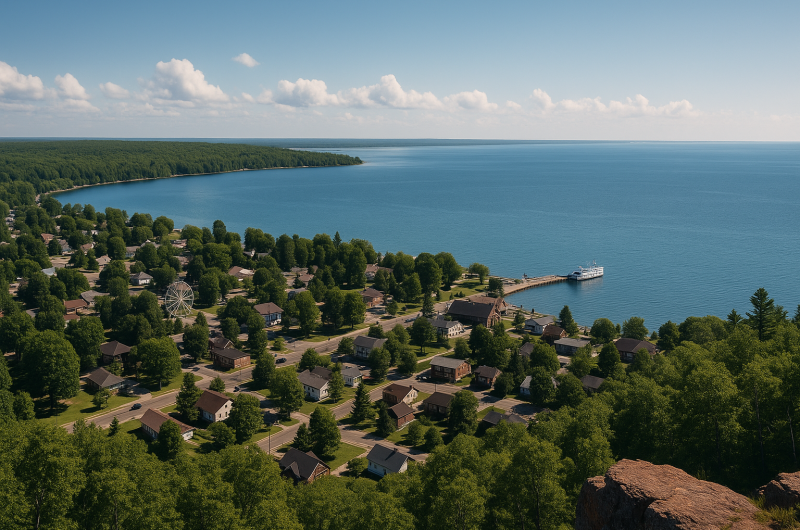Home Ownership and the American Dream in the Upper Peninsula

It is unusual in these contentious times for Democrats and Republicans to agree on anything, but the issue of housing – and the need for more of it – may be the exception. During 2025’s October government shutdown, the U.S. Senate passed the bipartisan Renewing Opportunity in the American Dream to Housing Act of 2025. It’s no accident that the proposed legislation includes the “American Dream” in its title. As a recent commentator on Rural Insights noted, that dream involves owning “a home of your own.” This article examines recent changes in homeownership levels across the U.P., and the factors pushing the dream of homeownership out of reach for many of its residents. But first, an overview is provided of why home ownership is central to the American Dream.
Home Ownership and the American Dream
Unlike many other countries, Americans value owning a home over renting, due to its many financial benefits. Between April 2015 and April 2023, for example, the average seasonally adjusted US home price increased nearly 80 percent, providing homeowners with a significant increase in wealth, while renters were left out. The financial system rewards home ownership. Mortgage interest is tax deductible, benefiting higher income taxpayers, while 30-year fixed-rate mortgages keep monthly mortgage payments stable and protection from inflation and interest rate increases. When mortgage rates drop, homeowners can lower their borrowing costs by refinancing. In short, homeownership is a major source of wealth. But not all Americans share in the benefits of homeownership. According to the Census Bureau, approximately 72 percent of white households owned their homes in 2015–2019, compared to 47 percent for households of color.
Home Ownership in the Upper Peninsula
The Census Bureau estimates homeownership rates for counties based on five-year survey data (Table 1). All U.P. counties have a higher rate of homeownership than the state, with ten counties having a rate of over 80 percent. Moreover, these data provide little evidence of a recent decline in rates across the region. The lowest rates are associated with counties with a university and an associated need for student rental accommodation, e.g. Houghton, Marquette and Chippewa.
One possible explanation for the U.P.’s high rate of homeownership is the region’s aging population. For example, Ontonagon’s median age, in 2023 is 59.4, up from 52 in 2010. The comparable data for Schoolcraft is 52.1 and 47.5. A high median age indicates a lack of young people and so-called “aging in place;” people staying in their own home as they get older. These people were able to afford purchasing a home at an earlier time when the American Dream was attainable.
The Rising Cost of Homes in the Upper Peninsula
The US Federal Housing Finance Agency has developed a House Price Index using appraisal values and sales prices for mortgages bought or guaranteed by Fannie Mae and Freddie Mac (two Enterprises set up by Congress to promote homeownership). The Index has a value of 100 for the year 2000 enabling the comparison of home price values over time (Table 2). These data show that for the period 2000-2020, most counties experienced a gradual increase in Index values. Then between 2020 and 2023 the Index shot-up, with the largest increases (+80) occurring in Alger, Gogebic, Mackinac and Marquette, followed by Houghton, Keweenaw and Iron (+70).
The recent jump in home price reflects an increase in demand as a result of in-migration to the region during Covid. With few homes on the market, sellers were able to raise their prices. When there is a short supply of a particular good, it might be expected that the market would respond by increasing the supply and bring down its cost. This is not the case for housing in the U.P. In Marquette County, for example, according to Realtor.com, the housing inventory as measured by new monthly listings peaked in June 2019 at 148; by June 2025 the equivalent figure was 84. Not surprisingly, a lower inventory has translated into higher home prices. The median listing price during the same period rose from $210,000 to $367,450, a 75 percent increase. This increase might not pose a problem for potential home buyers if incomes had risen a similar amount, but they have not; Marquette County’s median household income from 2019 to 2023 (the latest date for which data are available), rose just 13 percent, making homeownership less attainable for first time home buyers.
Rising Construction Costs
Meeting the demand for housing is further complicated by the rising costs of new home construction. A new, 1,200 square foot, 2-bedroom home, for example, on the city’s south side is currently listed for sale at $499,000. According to the National Home Builders Association (NHBA), construction costs accounted for 64.4% of the average price of a new home in 2024 compared to 60.8% in 2022 (the finished lot was the second largest cost at 13.7%). The NHBA attributes part of the increase in construction costs to inflation in building material prices. The U.S. has a long history of importing softwood lumber to use in construction from Canada. Tariff policies to protect the U.S. lumber industry have been in place since 2017 and currently stand at 45 percent. Yet despite this protection from foreign imports domestic lumber production has not increased, since the artificially higher prices (due to the tariffs) have lessened the incentive for firms to expand their output.
A shortage of construction workers is driving up labor costs and adding to the cost of new homes. Last summer construction firms estimated that 248,000 construction jobs remained unfilled at the national level. Immigrant workers have been essential in filling this gap. According to the Urban Institute, immigrants made up more than 23 percent of the construction workforce in 2023, with about half of them undocumented. The well publicized ICE raids at job sites in 2025 have only exacerbated the labor shortage.
Final Thoughts
U.P. homeownership rates are currently higher than the national and state averages, but this is largely a function of “aging in place,” while rising home prices present a significant obstacle for young people to acquire their portion of the American Dream. U.S. homeownership peaked at 69.2 percent in 2004, since then it has dropped to 65 percent. Unless there is a way to make housing more affordable, the American Dream is likely to slip further out of reach.






The land prices increase as much as, if not more than, the actual house. Government needs to get away from property taxes as well. Buying an existing home likely results in higher taxes for the new owner and they continue to go up annually even if wages don’t. The cost of maintaining a property never factored into the costs of ownership, that I’ve ever seen. Insurance also increases a rate far outstripping inflation. The Federal Reserve controls interest rates and shows little inclination to bring them down.
To paraphrase Klaus Schwab: You will own nothing and like it.
Well noted Robert. Homeownership involves more than the purchase price. With stagnant wages, high interest rates and unending taxes and homeowners insurance, drives many from ever being able to obtain “The American Dream.”
I have owned three different properties in the UP over the past 30 years. Being from northern IL I was always amazed at how affordable homes/properties in the UP were in comparison to IL. Now that I want to buy a permanent primary residence (my last home) in the UP, in an area I fell in love with decades ago, the costs are astronomical. Even lodging at local motels has become unaffordable for many including myself. Many folks I know and friends in Alger County can’t afford to buy their own home. Folks can’t sell their residence because they can’t afford the new home looking to downsize. A real shame that so many feel stuck (can’t afford to move and can’t afford to stay).
Are cabin and recreational homes considered with this article?
I have the same question. Thanks for asking it first Pamela.
A little known fact/reality check here!
And your take on Federal Reserve
While our friend Robert Beckendorf quotes Quote Klaus Schwab with with the comment
From the son of a nazi, something for all of us to look up too??
“To paraphrase Klaus Schwab:” You will own nothing and like it.”
I’ll bet he he may have heard the same comment from his loving Papa given his allegiance to being the son of a Nazi,
Eugen Wilhelm Schwab and Erika Epprecht in Ravensburg. His parents had moved from Switzerland to Germany during the Third Reich in order for his father to assume the role of director at Escher Wyss AG, an industrial company and contractor for the Nazi regime.
And no one working for Nazi regime was allowed such a job with out a pledge of allegiance to Adolf Hitler!
The only difference being that as his daddy, son Hitler and his low-life killing machine might have said
WE WILL TAKE ALL ALONG WITH YOUR LIVES!!
Never fails to amaze me here as gentleman like Mr Benkendorf and his protege Mr Wood give their praise to some of the most terrible humans and their friends as something that they want all of us gullible yoppers to look up too!
BS Mr Benkendorf and Mr Wood
Now how do you guys Salute??
POSTED HERE JULY 2025 AND NEVER A COMMENT UNTIL I READ THE PROFESSOR IN THIS ARTICLE???
Question Here???
With the major acquisition of land by Singapore where the hell are the reporters the people of the UP ???
Do you all sleep while foreign nationals buy up 540,000 acres and just a big Ho-Hum yawn ……Really????
Here’s a really interesting question to the perpetually sleeping UP-residents.
How many of you own any property here in your home state??
Or can afford too own a home, build a future for your families?
While your loved ones struggle in poverty, lack of food, health care quality schools….as you struggle to just ride the razors edge??
And now to hear that foreign nationals mean more to the politicians and well connected in government, your not even worth asking (Michigan citizens) what you might think??
MY GOD WHY NOT ALLOW THEM TO JUST EXTINGUISH YOU AND YOUR FAMILIES QUICKLY, AND SAVE ME THE PAIN OF WATCHING YOU ALL WILLINGLY MARCH YOURSELVES INTO THEIR OVENS!!
Something definitely stinks here at all levels of government and soon it will be your corpses (speaking metaphorically)
To paraphrase a famous Pink Floyd lyric.
“IS THERE ANYONE OUT THERE?”
OR IS THIS LANDSCAPE THEY CALL THE UP JUST DEVOID OF THOUGHT??
I honestly don’t know anymore, like screaming a warning in a cemetery…..Wow as for me and my house we will not go willingly into oblivion.
Thank you, Michael Broadway, for laying out the facts as you see them. IMO, all of the turmoil is directly related to several factors. Seniors , a growing segment of our population and living longer than ever, shelter in place reducing the available properties for purchase. On the influence of inflation, it has has only very recently (last couple of years) become a factor in the price of anything including properties. This has been exacerbated by the emergence of increases in millenial income and their position in the cycle of life, they want to buy homes thus increasin demand and that is normal and not new. Tarrifs are a recent phenomena, and while real, it’s a cyclical influence on the price of building that will (hopefully) abate. The lack of building trades personnel is a large factor, and one that could take only a few years to resolve if we shift our focus from college to the trades. Except for in urban areas, land availability is not an issue, especially in the UP. I welcome comments from your readership.